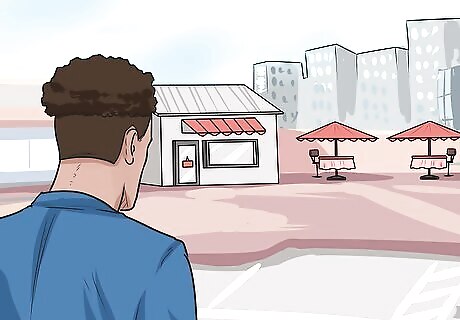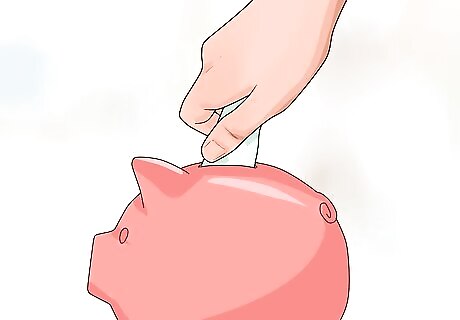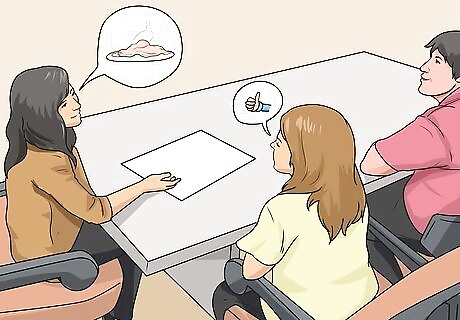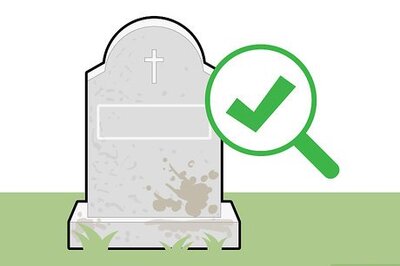
views
X
Research source
As with starting any business, you will need to take many things into consideration throughout the process of establishing your restaurant or coffee shop. Do you need a loan? How much money will you need? Where will the business be? How is it going to attract customers from other businesses like yours? These are some of the considerations that should help you gather your plans and begin to form them into a business.
Laying the Groundwork

Determine whether owning your own business is for you. Most restaurant and coffee shop owners are driven by a passion for what they do. This carries them through the hard times and the risk of failure that accompany all small business ventures. In addition to having a passion for your business, you should make sure that your personality is a good fit for the uncertainties of business ownership. For example, are you comfortable with the unknown? Can you take risks that may or may not pay off? How comfortable are you being a self-promoter? Can you “sell” your business to strangers and your community? Are you willing to work long and/or unusual hours to keep your business afloat? Are you comfortable being the person responsible for your success or failure? Do you enjoy problem-solving and creative thinking?

Check out the environment. The environment in which you open your restaurant or coffee shop has a significant effect on its success. It’s very important to consider factors such as the location, how fast you can grow the business, and what makes your business different from its competitors. You will need to do significant market research in order to learn about where the best location would be, what types of customers you might attract, and what customer needs are currently not met that you could meet. Sources such as the National Restaurant Association and Nation’s Restaurant News can be helpful to obtain industry data.

Talk to other small business owners in the area. Networking with other owners of restaurants and coffee shops will help you understand more about the process from a first-hand source. It’s a good idea to ask about the challenges and difficulties they faced, as well as what strategies they used to overcome those challenges. Remember that small business networking is a two-way street. Make sure that you thank people who talk with you for their time, and offer to help them once your own business is up and running. This will also help generate goodwill toward your business.

Decide on your market. You need to decide who your target audience is. Even though most people eat out at least occasionally, there is no way that you will be able to appeal to everyone. Trying to do so is actually a recipe for failure. Focus on the niche that your restaurant or coffee shop can appeal to. For example, a restaurant that serves steaks, Chinese food, Italian pasta, and fresh seafood would probably be confusing to most customers. Businesses that specialize in a particular area are more likely to draw a following. Pick a few things for your business to do and do them impeccably. You should also think about the demographic in the area where you want to open your business. Who frequents the existing businesses in the area? Millennials, who often prefer fast/convenient food or quirky, locally sourced food? Families, who often focus on value for the money and family convenience? Professionals, who often spend on “fine dining” experiences? You want to look for a balance between filling an unexploited niche while not aiming your business at customers you’re unlikely to draw. You should also decide whether you want to open a “fast food” restaurant, a midscale restaurant, or an upscale restaurant. Knowing whether your demographic is more likely to be interested in value or fine-dining “experiences” will help you determine what type of business will be most successful.

Figure out your concept. All restaurants need a “concept,” or something that lets customers know what to expect. This doesn’t have to be highfalutin or expensive, but it should present a clear “vision” of what your restaurant will offer. For example, if you love your grandmother’s fried chicken and soul food, centering your restaurant on that tradition will be your “concept.” You wouldn’t also offer hamburgers or Korean food at your soul food restaurant. Consider your location as well. For example, a restaurant centered around “fresh seafood” makes sense when you live near a river or ocean, but less sense if you’re far inland from any source of fresh seafood. The cost of those ingredients will be higher, and it will be harder to find quality. Coffee “concept” shops are increasingly popular as well. Customers are interested in buying coffee that is fair-trade, organic, and other markers of quality. Decide whether you want to be more of a “boutique” coffee experience or more of a traditional “doughnuts and coffee” venture. Stick with that identity. EXPERT TIP Alex Hong Alex Hong Executive Chef & Restaurant Owner Alex Hong is the Executive Chef and Co-Owner of Sorrel, a New American restaurant in San Francisco. He has been working in restaurants for over ten years. Alex is a graduate of the Culinary Institute of America, and has worked in the kitchens of Jean-Georges and Quince, both Michelin-starred restaurants. Alex Hong Alex Hong Executive Chef & Restaurant Owner Take your newfound autonomy as a chance to be creative. Alex Hong, the Executive Chef and Owner of Sorrel, says: "I love having the freedom to be creative in my restaurant, to change up the menu, or do whatever I want. To just take ownership of everything that happens in this restaurant—it excites me every day."

Determine whether you want to start from scratch or buy an existing business. While the failure of independent restaurants is much lower than commonly thought -- only about 30% in the first year -- the turnover rate is significantly higher than that. Owners of restaurants and coffee shops frequently look for a new owner to hand the business to. If the business is already fairly successful, taking over an existing business could be a good idea. If you choose this route, make sure you still do your research to learn why the owner wants to sell. Is the business profitable? Does it have a steady stream of customers? Does the owner just want to retire, or is the business having trouble that the owner wants out of? Another option is franchising. Opening a franchise of a successful restaurant chain can be a good way to achieve instant brand recognition and access a loyal customer base. However, you will not have as much control over your product and operations as you would if you open an independent business.

Figure out your budget. Starting a restaurant or coffee shop requires start-up capital. How much money you’ll need can vary dramatically, depending on your location, the scale of your venture, and how much investment your property requires. There are several online calculators you can use to get a rough idea of starting costs. It’s a good idea to keep your ambitions small, at least at first. Once you have built your reputation on your menu, you can expand. You could start as small as a kiosk focused on providing one delicious dish or beverage type. Make sure you research average salaries and wages in your area as well. You will need this information when you write your business plan. Plan on not turning a profit for at least the first six months. Set aside enough money to cover your personal expenses for six months at minimum.

Write a business plan. The US Small Business Association has excellent and extensive advice on writing a business plan on their website. A fully developed business plan will make sure there are no nasty surprises once you begin the process of opening your restaurant or coffee shop. A business plan has many elements. It’s important to have a very clear idea of your restaurant’s identity, including what food it will serve, its location, and its long- and short-term goals. Present a clear breakdown of all costs. State the amount of the lease or mortgage, how much salaries and wages will cost, how much benefits packages will cost, how much furniture and equipment will cost, how much your food products will cost, etc. Develop a clear marketing strategy. You should be absolutely clear on who your target market is and what actions your business will take to draw them. You should know who your competitors are and how you will compete with them. In this section, you should also present the average costs of the types of marketing you’ll use, as well as any licensing and permit requirements. Include your menu. Make sure that you know exactly what your restaurant will serve. Know what distributors you will purchase food from and how much items will cost. Consider these costs when pricing menu items.

Secure funding. Once you have a solid business plan in place, you’ll need to secure funding. Starting a restaurant or coffee shop can be done with just a few thousand dollars, or it can require several hundred thousand dollars. Don’t borrow or spend more than you need. You can use personal resources, such as savings accounts and credit cards, as start-up cash. You can also go in with a partner or two, particularly if your business plan is convincing. Just make sure you draw up a clear partnership agreement document. The US Small Business Administration (SBA) can connect you with lenders and other programs to support small businesses.
Making the Initial Decisions

Consult with a professional. You will need to have some kind of legal structure for your business. Consulting with an expert, such as a small business attorney or a Small Business Administration office, will help you make sure that your business gets what it needs to succeed. A small business attorney can help you figure out what the best structure will be for your needs. An attorney will also be able to guide you through the process of obtaining permits and licenses, as well as ensuring that you comply with any regulations in your area. The US Small Business Administration has District Offices throughout the country that offer free counseling and advice about how to start a small business. You can find a local office on their website. They also have over 900 “Small Business Development Centers” (SBDCs) that can help you plan and execute your business decisions. Many restaurant and coffee shop owners go with a Limited Liability Company (LLC), which protects your personal assets in case the business runs into trouble. While you can run your business as a “sole proprietorship,” this is usually not a good idea, as your personal assets are usually on the line if your business incurs liabilities. You may also want to consult with a small business accountant. The work of running your restaurant may be so much that you need to hand the bookkeeping over to someone else.

Research local zoning laws. Restaurants and coffee shops are small businesses, so they must be located within a commercial zone. You must acquire the necessary permits and other documentation before proceeding. Most areas will not allow you to sell food or beverages unless you have a commercial kitchen on-site. This means that home-based businesses are usually out. The SBA has a “Permit Me” tool that will help you determine what licenses and permits your state requires.

Research your local food safety laws. Health codes vary depending on your location, but in order to establish a business that will sell food and/or drinks, you must comply with all the local regulations regarding food safety. Be aware that you will generally need to submit your application to your local environmental health department at least a month in advance of opening your business. You should also be aware of any particular regulations involving the sale of alcohol. While laws vary depending on your location, the laws surrounding alcohol are generally complex, so make sure you understand them.

Find a location. You’ll want to make sure that your restaurant or coffee shop is in a convenient, easily accessible location. Often, nearby businesses will help generate foot traffic that can benefit your business too. It is generally much cheaper to renovate an existing restaurant or coffee shop than it is to build one from scratch (or convert a non-eatery to an eatery). You may want to lease rather than purchase, especially if you have never operated a small restaurant or coffee shop before. Make sure to consider things like parking facility, rent rates, and city/county ordinances when choosing your space. Check out the history of the site, too; if there have been eight failed restaurants in your space before yours, there could be something about the site that isn’t great for food service establishments.

Purchase insurance. Restaurants and coffee shops have many areas that could open you up to liability, including worker safety, food safety, and liquor liability. Many areas require any restaurant or coffee shop that sells alcohol to carry liquor liability insurance, which will protect your business against lawsuits or liability from wrongdoing resultant from alcohol consumed at your business. In most areas, you’ll also need to carry workers compensation insurance. Even if not required, insurance is an excellent idea. Property insurance and general liability insurance will help protect you and your business.
Setting Up Shop

Listen to your instincts. Once you’ve done your research, listen to your gut when making business decisions. Don’t worry about what is “trendy” or the latest “must-have.” Focus on the important things, such as good quality food or coffee, excellent service, and a solid location. Don’t let other people push you around with their own ideas. Remember that what works for one business may not work for another. Just make sure that you’re basing your decisions on research.

Look for bargains. You don’t have to spend a fortune to establish a small restaurant or coffee shop, especially if you shop smart. Repurpose whatever you can. Buy wholesale from restaurant supply shops. See if contractors and other service providers will work for barter. If you need to establish branding for your business, consider contacting a local design school or university with an advertising department. Often, students will be glad to develop excellent low-cost work for you in exchange for getting to use it in their portfolios. Leasing big-ticket items such as refrigerators and espresso machines, at least at first, can help cut down on start-up costs. This means you will be able to keep lower prices, which will mean happy customers. You may also be able to find equipment offered on sites like craigslist. Just make sure that it is in good working order.

Design your space with care. The dining area of your restaurant or coffee shop is the place where your customers will spend their time. It communicates your restaurant’s identity and is crucial to customers’ impressions of your business. Usually, between 45-65% of your floor space will be devoted to the dining area. Visit other restaurants or coffee shops in your area. Observe how customers interact with the space. Does it seem comfortable? Efficient? Inviting? Make sure you have flexible seating. Booths for larger groups should be placed along the walls. Remember that 40-50% of customers arrive in pairs. 30% come alone or as a party of 3. Just 20% of guests come as groups of 4 or more. Use primarily tables for two that you can push together when necessary. For coffee shops, make sure that you have a comfy seating area that’s conducive to working and socializing. A mix of chairs and couches with 2-person tables will create an inviting environment in which customers will want to stay for awhile.

Hire staff. Don’t overhire at first. Be willing to fill in gaps yourself until your business is profitable enough for you to hire more personnel. You can advertise online, in classifieds, and through word-of-mouth. Create a training guide so that your employees know what is expected of them. Setting clear roles and expectations will help things run smoothly. For coffee shops, hire well-trained baristas. Coffee quality is the live-or-die element of coffee shops. Even if you buy the best espresso in the world, if your baristas don’t know how to prepare it, your coffee won’t draw customers. Be aware of turnover. Food service is very prone to employee turnover, where employees join and leave a company within a short amount of time. Make sure you have ways to quickly hire new people when you need to. Make sure you’re aware of and comply with your local Department of Labor regulations. Even if you hire family, make sure that each person has a clear understanding of their duties. All laws and regulations apply to family-member hires, too.

Make a list of every single supply you need. Before you choose a supplier, you have to know every single product that your business will need. This ranges from obvious items like “eggs” and “tables” to tiny details, like “napkin holders” and “toilet paper.” Make a comprehensive list so that you know exactly what your business will need each week. Categories to think about include equipment (stoves, refrigerators), furnishings (lighting, tables, chairs), dinnerware (glasses, plates, silverware), and miscellaneous details (cocktail stirrers, toothpicks).

Find your suppliers. You will want to provide your customers with the best-quality products for their money. There is a wide variety of suppliers out there, from those who specialize only in seafood to those who will do everything from toilet paper to T-bones. If you talked with other restaurant and coffee shop owners, you may be able to get recommendations from them. Make sure you balance between cost and quality. Start with a list provided by your local branch of the National Restaurant Association. Check out any potential supplier with your local Better Business Bureau. If a business has a history of complaints, steer clear. Comparison shop. Ask for price quotes on everything you’re likely to need and compare between suppliers. Consider your staff’s talents. It may be more cost-effective for your staff to clean its own seafood, but if you don’t have anyone who knows how to do that, it won’t actually save you any money. If your staff has skills like bread-baking, though, make use of them. Make sure the company you choose is responsive. If they can’t get something to you in time, will they let you know? Are they conscientious about delivery schedules? Do they reply to inquiries in a timely manner?

Test your menu before you open. Even the best menus need fine-tuning at times. Host a small party for people whose opinions you trust and prepare your menu offerings for them. Ask for their feedback, and make changes as necessary. Tell people what the price will be at the restaurant and ask them how they think about it. You may need to bring your prices down, or you could be pleasantly surprised to learn you can charge more while still offering value.
Growing Your Business

Market your business. Your business plan should already have detailed marketing plans in place. Your goal is to make your business visible to customers and provide a compelling reason for them to visit. Form social media accounts, run ads in your local papers, and make yourself a public figure by visiting locales like fairs and farmers markets. Gift-certificate giveaways and “free food” promotions are very popular ways to draw attention to your business. You can also donate gift certificates as prizes for local charities, nonprofit, and professional organizations. This will generate goodwill toward your business and spread the word about your business. Consider inviting your local food critic to your business. While you can’t control what they write, it’s a good way to get some press for your business. Loyalty cards work well for fast-food restaurants and coffee shops.

Stay in touch with customers. Even if you meet with success once you open up, don’t rest on your laurels. Give surveys. Ask your customers what they like and what they don’t like about the business. Ask what they would like to see that you aren’t currently doing. Ask how they feel about your location, your interior, your menu offerings. Listen to what your customers say, regardless of how it may make you feel. You can even incentivize these surveys by offering a free product or meal if customers return the survey to you.

Keep an eye on expenses. Once you’re up and running, the biggest day-to-day expense you face will be the cost of food and beverages. However, you should make sure that your food and beverage costs don’t add up to more than 25-40% of your revenues. Payroll is another reliable chunk of expenses. In general, payroll should cost no more than 20-25% of revenues.

Upsell. This is especially important for coffee shops, where the average transaction is fairly small (usually, around $3). Make sure that you also have plenty of accompaniments, such as pastries and muffins, and encourage your staff to recommend them to all customers. Coffee should not be more than about 40% of your weekly sales volume. Don’t go overboard with the accompaniments, though. Have a good selection, but you don’t need to have six types of quiche and twelve types of cookie. Trying to sell too much of a variety increases costs without increasing benefits.


















Comments
0 comment